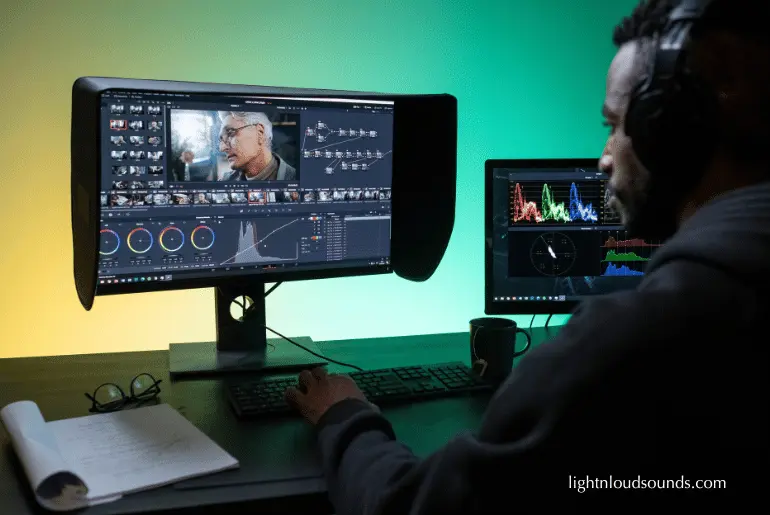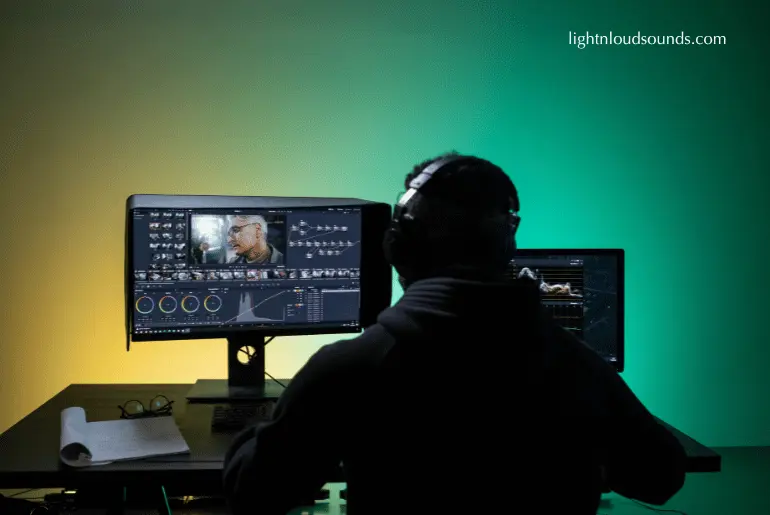In audio editing, the volume at which one listens through headphones can drastically influence the final product. The right volume ensures accurate perception of nuances, balancing of elements, and appropriate adjustments. It is not just a matter of personal comfort; the volume setting has implications for both the quality of the edit and the health of the editor’s ears. Understanding the optimal headphone volume is thus a crucial aspect of the editing process.
In this post, I’ll talk about the recommended volumes for audio editing and how volume affects audio production.
Post Contents
What Volume Should My Headphones Be at When Editing?
When editing audio, it’s essential to set your headphone volume at a level where you can clearly discern the intricacies of the sound without causing hearing discomfort; that’s around 60-70% of the headphone volume. Ideally, sound effects should range between -10dB and -20dB to prevent distortion.
Using quality headphones will provide a more accurate representation of the sound. Continuously monitor the audio levels across your timeline to guarantee consistent and even playback of all clips.
How Does Volume Affect Audio Production?
1. Perception of frequency response
Our ears perceive different frequencies differently at varying volumes. Human hearing is less sensitive to extremely low and high frequencies at low volumes, adhering to the Fletcher-Munson curves or equal-loudness contours. Therefore, if audio is mixed at an inappropriate volume, the balance of bass, mids, and treble can sound off when played back at other volumes.
2. Dynamic range and detail recognition
Volume plays a crucial role in our ability to detect subtle details in a recording. Nuances and quieter elements become more evident at higher volumes, while at lower volumes, they might be missed. This dynamic range can be misjudged if the monitoring volume is not consistent.
3. Risk of distortion and clipping
Playing audio at volumes that are too high can lead to distortion, especially if the equipment can’t handle such levels. This distortion can mask issues in the mix, leading to a compromised final product. Furthermore, pushing volume levels too much can result in clipping, where the audio peaks and distorts unpleasantly.
4. Ear fatigue and long-term hearing damage
Extended exposure to loud volumes can lead to ear fatigue, affecting one’s ability to make accurate judgments in audio production. Over time, consistently high volumes can also cause permanent hearing damage, impairing an audio professional’s most critical tool: their ears.
5. Impact on emotional resonance
Volume can profoundly affect the emotional impact of a piece. A quietly mixed intimate dialogue might evoke vulnerability, while a loud explosion conveys power and intensity. Understanding and manipulating volume is, therefore, vital to achieving the intended emotional response from the audience.
How to Set Perfect Audio Levels When Editing

1. Compare audio levels to a reference track
One of the initial steps in ensuring ideal audio levels is to use reference tracks. These are professionally mixed and mastered tracks that are similar in style or mood to the piece you’re working on. By comparing your audio levels to a reference track, you can get a better sense of where your mix should be in terms of overall loudness and frequency balance.
2. Maintain a consistent monitoring level
It’s essential to maintain a consistent monitoring level in your editing environment. Keeping the volume at which you listen to your edits consistent ensures that you’re not making adjustments based on variable loudness perception. This helps in achieving a mix that sounds balanced at most playback volumes.
3. Avoid pushing the levels to their limits
While making your audio as loud as possible might be tempting, this can lead to clipping and distortion. Instead, aim for a healthy average level, ensuring that peaks don’t hit the red on your meters. This provides room for dynamics and ensures clarity.
4. Be wary of ear fatigue
Spending long hours editing can tire your ears, making them less reliable. Taking regular breaks or switching to a different task for a while is advisable, allowing your ears to rest. This ensures that when you return to the editing, you’re hearing with fresh ears and can make more accurate judgments.
5. Use compressors and limiters to maintain a consistent audio level
These tools control the dynamic range by boosting quieter parts and attenuating louder sections, resulting in a more even and polished sound. However, using these tools judiciously is essential, as overcompression can strip the audio of its natural dynamics and feel.
Conclusion
To produce the best audio results when editing, it is imperative to set headphone volume at a level that is neither too loud nor too soft. An appropriate volume setting aids in the accurate discernment of audio details and ensures that the final output is balanced and clear. Moreover, safeguarding one’s hearing by avoiding excessive volume levels is equally vital. Editors must consistently be mindful of their volume settings, ensuring they balance clarity and safety.

